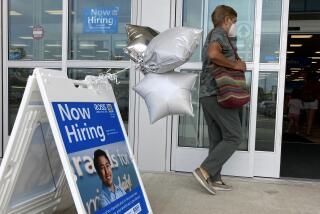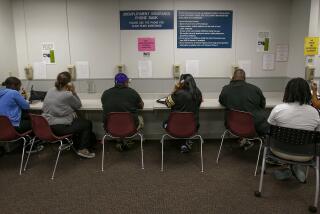U.S. Workers’ Productivity Drops Sharply in 2nd Quarter : Economy: Decline of 2.5%, the steepest in five years, reflects a slowdown in the recovery, analysts say.
- Share via
U.S. workers’ productivity took its sharpest drop in five years in the second quarter, the Labor Department said Wednesday, but economists said they were not alarmed because such a decline is often part of an expanding economy.
“The economy has made the normal transition from a recovery, where we get a burst of productivity . . . toward more sustainable growth,” said Gary Schlossberg, senior economist at Wells Fargo Bank.
“As you make that transition, productivity often slows or even declines,” he said.
Productivity--defined as the output per number of hours worked in the non-farm sectors of the economy--measures the time, effort and cost of making goods and providing services, and thus helps quantify the nation’s business efficiency.
In the quarter ended June 30, U.S. productivity dropped at a revised annual rate of 2.5%, the biggest decline since the first quarter of 1989, the Labor Department said. (The agency had initially estimated the latest decline at 1.2%.)
But this year’s second-quarter drop in output had followed gains of 4% or more in the third and fourth quarters of last year, when many firms responded to the economy’s rebound by garnering higher productivity from their existing employees to meet rising demand from customers.
“Businesses had been pushing their workers pretty much to the limit,” said Mark Vitner, an economist at First Union Corp., a Charlotte, N.C.-based bank holding company.
Since then, companies have been hiring more workers--the national jobless rate in August stood at 6.1% of the work force, compared with 7.6% two years earlier--with a resulting drop in productivity.
Indeed, output already had slowed in this year’s first quarter, when it registered a 2.9% gain.
“This is fairly typical during a slowdown period,” said David Wyss of the economic research firm DRI-McGraw/Hill.
One aspect of Wednesday’s report did slightly ruffle the financial markets, however: A revised 3.4% increase in unit labor costs, not the 2.0% increase that was initially estimated by the Labor Department.
The revised gain fueled some investors’ concerns about upward pressure on inflation--which erodes the values of stocks and bonds--and the threat of continued interest-rate hikes by the Federal Reserve to counter those higher price trends.
The Dow Jones average of 30 industrial stocks fell 12.45 points to 3,886.25. Prices of the Treasury’s benchmark 30-year bond, meanwhile, slipped about $2.50 for every $1,000 in face value, while its yield edged up to 7.56% from 7.53% late Tuesday.
In addition, the Commodity Research Bureau’s index of 21 commodity futures prices--considered a leading indicator of inflation--surged a full point. Sugar, cocoa, wheat and cotton prices were all higher.
“All of these things exacerbate people’s inflation fears,” said Fabio Savoldelli, who oversees $1.4 billion in investments at SBC Portfolio Management International in New York.
A separate Commerce Department report also indicated that the economic expansion is cooling off. Stocks of unsold goods piled up at the wholesale level in July, the department said, while sales declined after two straight monthly increases.
Inventories grew 0.8% to a seasonally adjusted $224.9 billion after falling a revised 0.1% in June. (The agency previously had said June inventories fell 0.4%.) Business sales, meanwhile, dropped 0.4% in July to a seasonally adjusted $168.5 billion, following an 0.8% rise in June that was originally reported as a 0.5% gain.
*
Times wire services were used in compiling this report.
Productivity
Non-farm business productivity, percentage change from previous quarter at an annual rate, seasonally adjusted:
2nd Quarter, 1994: -2.5%
Source: Labor Department
More to Read
Inside the business of entertainment
The Wide Shot brings you news, analysis and insights on everything from streaming wars to production — and what it all means for the future.
You may occasionally receive promotional content from the Los Angeles Times.











